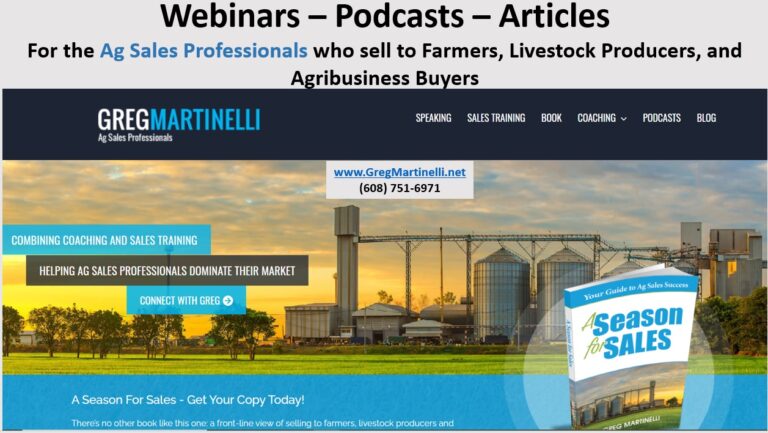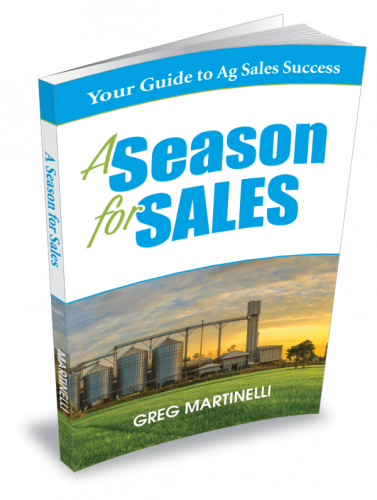Are you struggling to stand out and getting caught in price resistance?
During sales training workshops and coaching sessions, price resistance comes up as one of the salesperson’s biggest challenges. In many cases, the salesperson is selling the exact same products as their competition. Other dealers or Ag retailers are carrying the exact same products. In the workshops, we work through the different selling skills: from customer segmentation to asking better questions to eventually closing skills. This is when we get into the price resistance and value discussion.
Most sales training instructions will tell salespeople that price is not the issue, it’s all about selling value. I couldn’t agree more, except that the message is often misunderstood or misrepresented. The sales manager says, “I wish the sales team would quit calling me to request a lower price on our products. I wish they would sell the value of our products.” The salesperson hears, “You need to go out and tell customers about the value added features and benefits of our products…. more amino acids… higher growth rates…. improved animal or crop health…faster service.” The salesperson does this by going out and increasing their presentation on the higher value of their products. The problem is that the salesperson misinterprets who’s value they need to focus on. Instead of the product’s value, they need to be connecting to the customer’s value. More importantly, what is that value worth to the customer? What are they willing to pay for? How much is improved lean gain in their hogs worth? How much more will a customer pay for your “more reliable” service department?
Keep in mind that value comes in only three forms: money, time and emotion. For money value, you either increase their income or reduce their costs. For time value, you either save your customer time or help them get more done in a day. For emotion value, you either increase a positive emotion or decrease a negative emotion. Examples include: increased trust, reduced frustration, reduced risk, increased pride in the way their crops look, etc.
6 Ways to Add Value
-
Throw-Ins:
Some examples which we all love when we eat out are: free bread sticks, free refills, free bucket of peanuts and then being able to throw the hulls on the floor! If you are in the Midwest, you most likely know who the “home of the thrown rolls” is. Yes, it’s a restaurant that gives you as many rolls as you want to eat. However, they don’t just give them to you, they throw them to (or at) you from across the restaurant. Think about your business. What low cost products or services would make a nice additional offering to customers?
-
Sampling:
Too often, we forget that people are visual learners. They need to see it, touch it, and try it. This is especially helpful with livestock producers when it comes to something their livestock will consume. The most important step is that the animal wants to eat it. If not, the product is not worth any of the value it can deliver. Free samples and free demos are great ways for customers to see and involve all their other senses to understand the value your product brings. One of the challenges with sick or old horse is that they become picky eaters or stop eating altogether. We had a horse feed that horses loved immediately, even the finicky ones. Half pound samples were a great way to convince an owner that our product was better than what they were currently feeding.
-
Added Service:
What low or no cost service can you add to your offering? An example we all enjoy is a free car wash when you get it serviced at the shop. That might not make you pay $100 extra for service work, but then again, how often do you price shop service work?
-
Convenience:
We live in an on-demand, easy access, 24/7 world. Since many of our agribusinesses are old and mature, we feel this doesn’t apply to us. After all, we have been operating this way forever. Why change? One word – Convenience. In what ways are you not convenient to do business with? What hassles do your customers have when doing business with you? Examples include filling out redundant or unnecessary paperwork, remembering account or product information over and over again, even after years of buying those products, working with two or three different people to resolve one problem, etc.
-
Waiting:
Most of us have been in the doctor’s office, wearing nothing but a gown, freezing, while we wait an unknown amount of time for the doctor to finally show up. Isn’t it always nice when the nurse has the decency to lean in and tell you how long it might be? Uber created the greatest tool to the frustrations of waiting. I actually enjoy watching that little car navigate from where they are parked to my exact location. Where or what do your customers wait for? How could you either eliminate it or update them more frequently on how long the wait will be? This is an easy one for salespeople. If your company is struggling to make enough product for your customers. Or, if your delivery trucks are struggling to keep up with the demand, suffice it to say, your customers are frustrated by waiting. Any updates you can provide are better than no news at all. At least they know someone cares enough. Someone has enough empathy skills to know they are frustrated by waiting for your products. Don’t make the common mistake of avoiding the customer during these times. They won’t cool off or calm down. They will just decide that you didn’t care enough to even call and help.
-
The Bottleneck:
Every industry has it. That thing. That one issue. That one spot in their production line or service offering that slows all the others down. In feed manufacturing, it’s usually pelleting or delivery trucks. In grain elevators, it’s the dump pit or dryer. In Ag retail, it might be several: sprayer time, seed variety availability, the spreader time and of course weather windows to get all this done in a short period of time. In a service like vet service or crop scouting, it might be the number of hours it takes for the vet or agronomist to do their job during peak times. I know this isn’t a great revelation that this is a problem. Overcoming this problem might not be completely possible. However, some techniques you might use are:
- Isolate and eliminate: Ask yourself, which tasks, steps, processes can we isolate? Could we outsource that one task? Can we change when we do it?
- Seasonal help: Agribusiness is very seasonal. This causes seasonal bottlenecks in production, delivery and service. Can you simplify some of the steps in the bottleneck and bring in seasonal help to support this effort? Can this be designed for interns?
- Seasonal shift in work or work force: Agribusiness is very dispersed as is our customer base. So, it’s natural for plant managers or location managers to feel isolated and operate in a silo. While one of your locations in Kansas is being slammed by wheat harvest, the eastern corn belt is fairly quiet at that time of the year. Why not shift skilled labor, sales or management from the east to the west? Often, the main reason this isn’t done is a simple lack of coordination or just not thinking of asking for help.
I realize that some of these are small and minor actions that might not overcome all price resistance. However, unless you ask, you never know how important they are to customers. As a salesperson, think of yourself as the link between the customer and all the chaos that is going on in your industry and company. Reduce the stress of doing business with you as much as possible. Be there, when your customer needs you the most.


